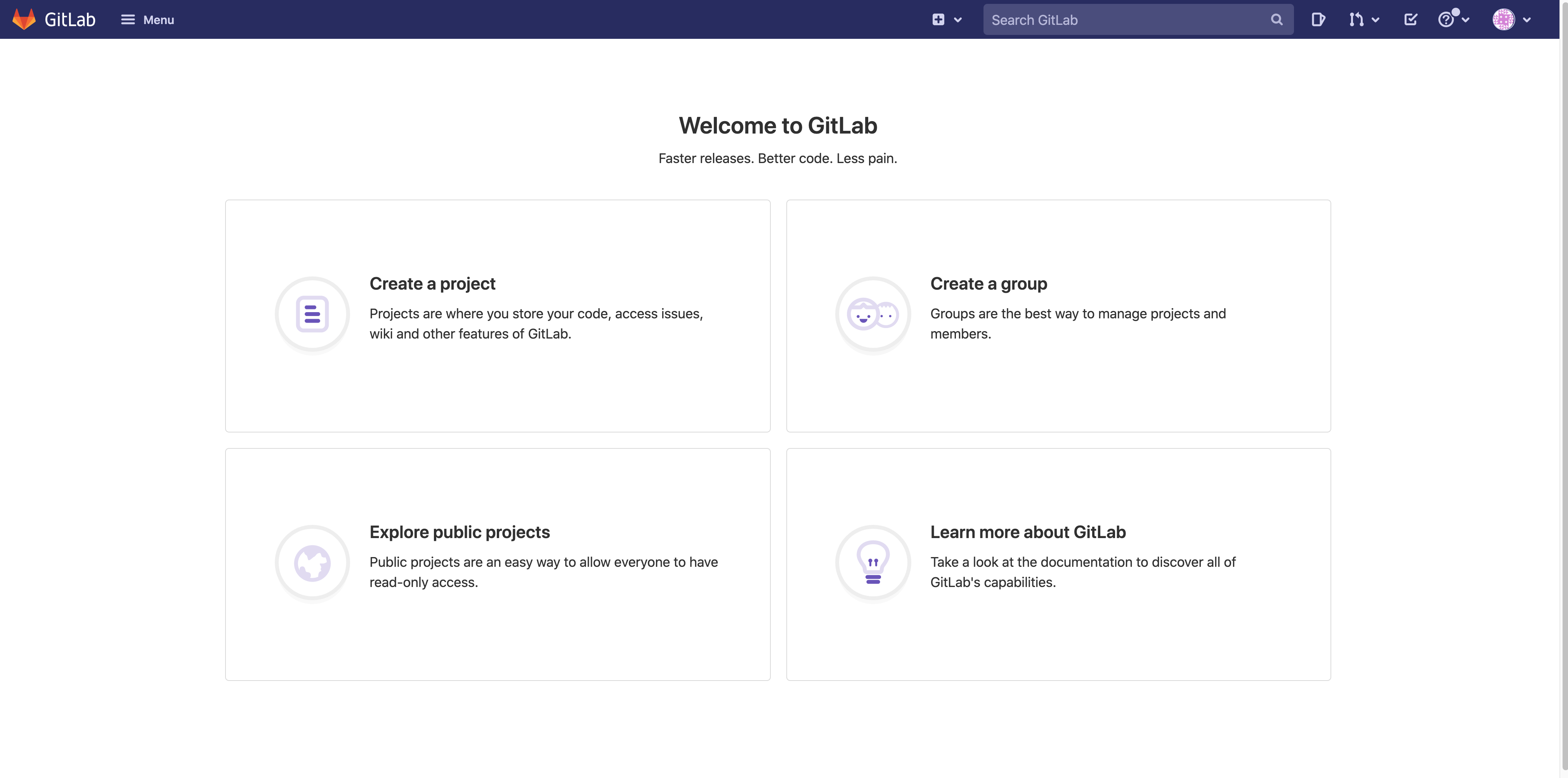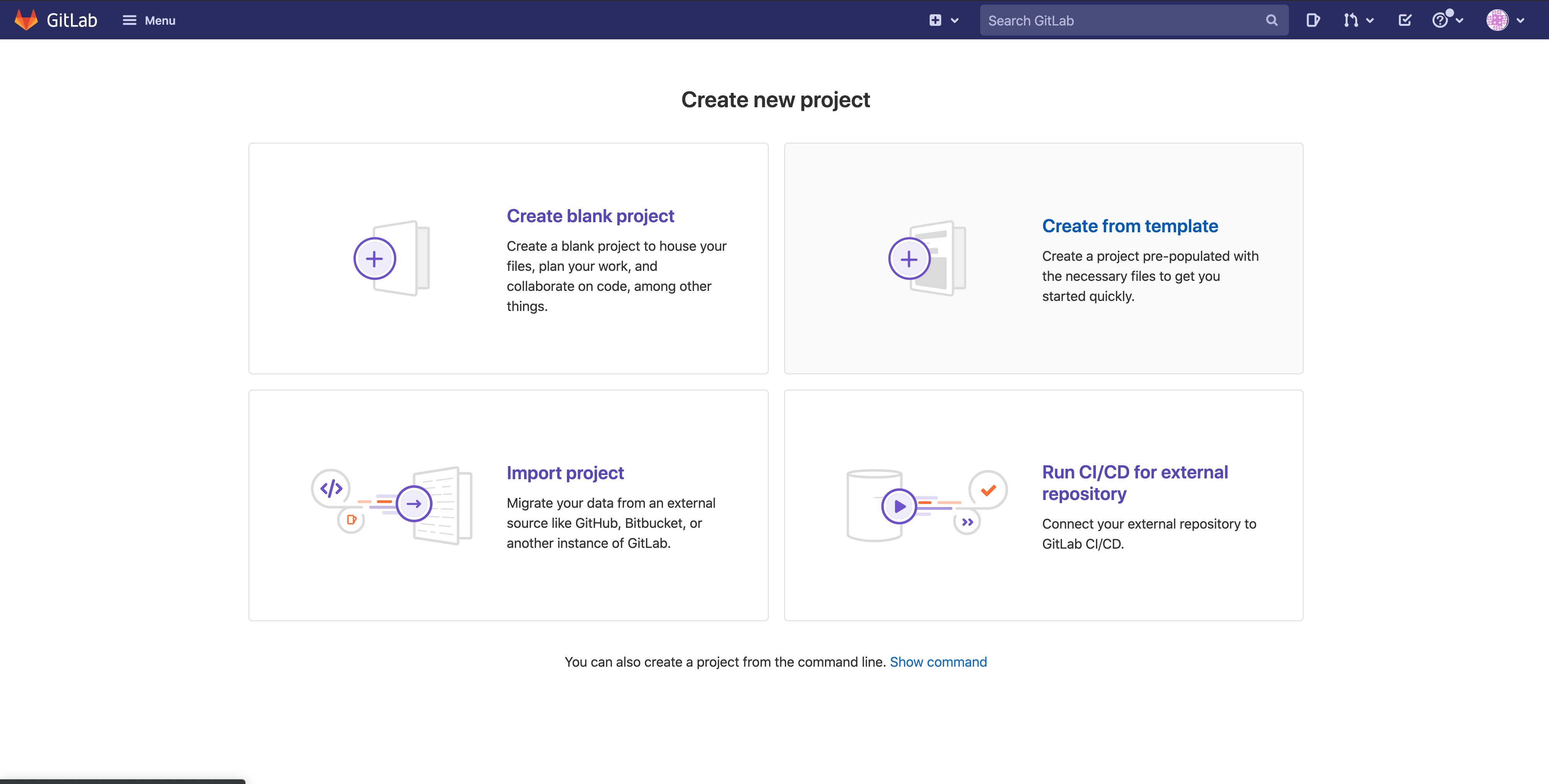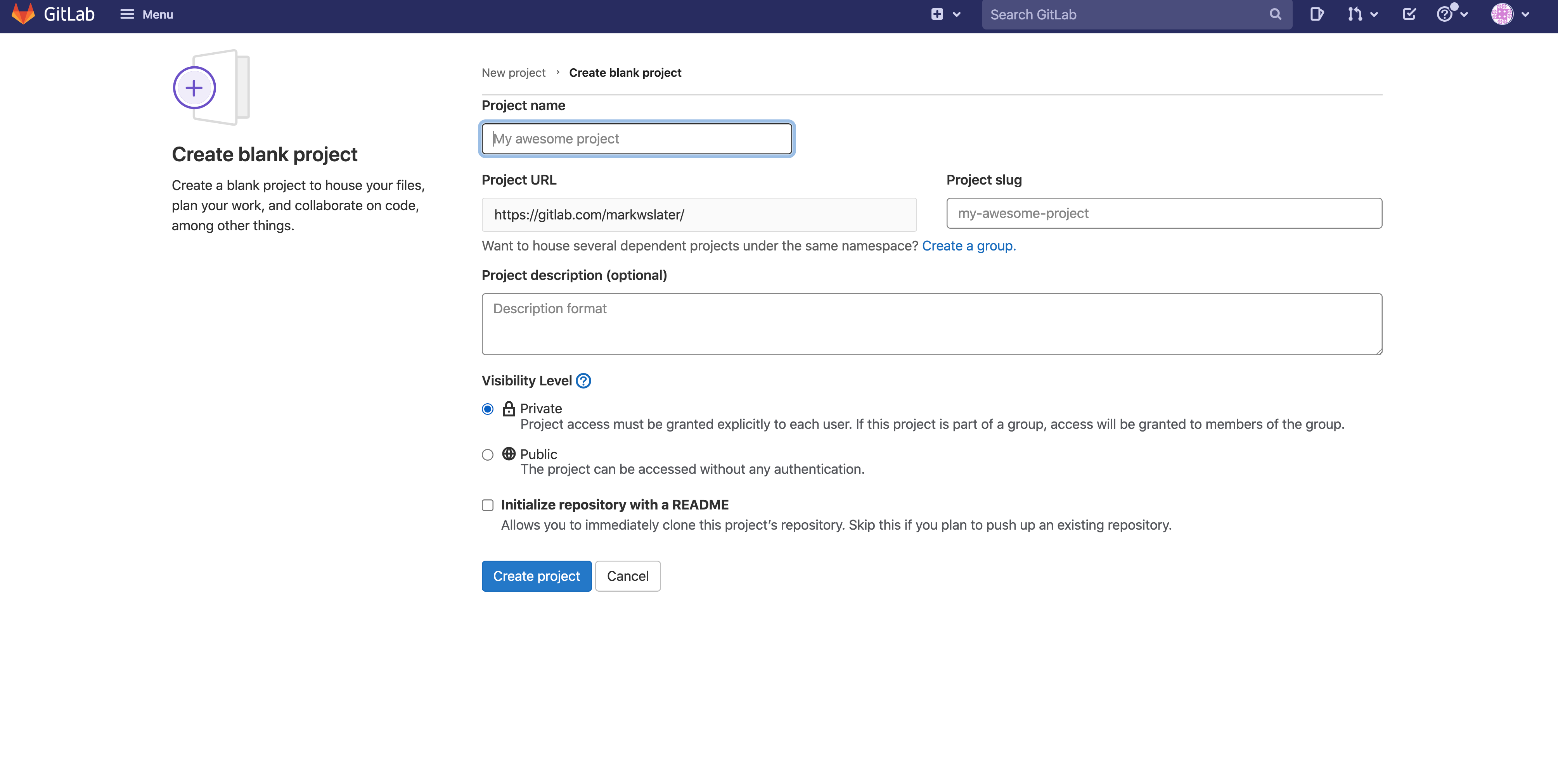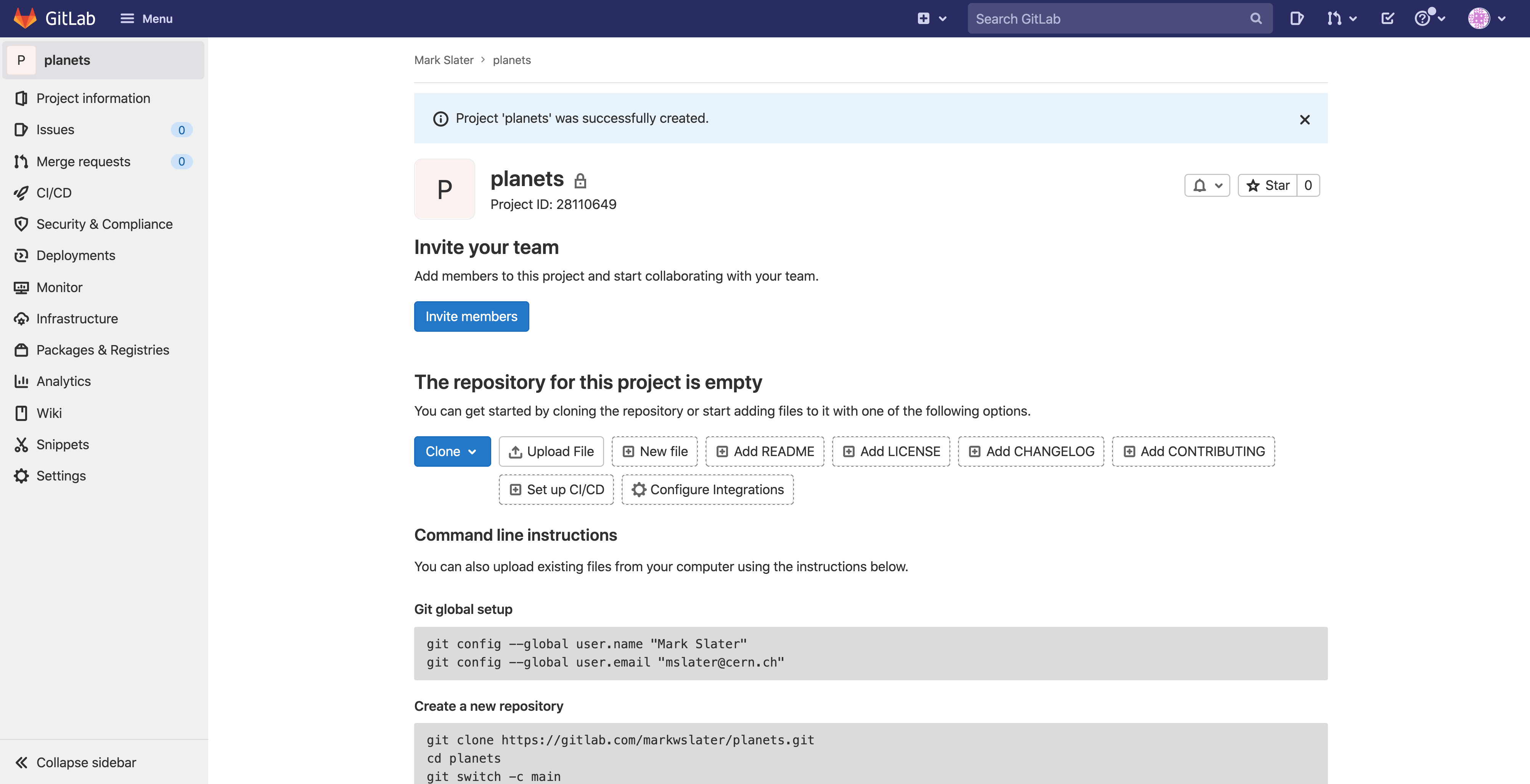Remotes in GitLab
Overview
Teaching: 30 min
Exercises: 0 minQuestions
How do I share my changes with others on the web?
Objectives
Explain what remote repositories are and why they are useful.
Push to or pull from a remote repository.
Version control really comes into its own when we begin to collaborate with other people. We already have most of the machinery we need to do this; the only thing missing is to copy changes from one repository to another.
Systems like Git allow us to move work between any two repositories. In practice, though, it’s easiest to use one copy as a central hub, and to keep it on the web rather than on someone’s laptop. Most programmers use hosting services like GitHub, BitBucket or GitLab to hold those master copies; we’ll explore the pros and cons of this in the final section of this lesson.
Let’s start by sharing the changes we’ve made to our current project with the world. Log in to GitLab, and from the main page, click on ‘Create a Project’:

On the next screen, click ‘Create Blank Project’:

You’ll now be presented with a screen where you can put in the details for your project. Name your project “planets” and then click “Create Project”:

As soon as the project is created, GitLab displays the ‘home page’ for the project. This would normally show any files the project is storing but there aren’t any yet!

This effectively does the following on GitLab’s servers:
$ mkdir planets
$ cd planets
$ git init
If you remember back to the earlier lesson where we added and
commited our earlier work on mars.txt, we had a diagram of the local repository
which looked like this:
Now that we have two repositories, we need a diagram like this:
Note that our local repository still contains our earlier work on mars.txt, but the
remote repository on GitLab appears empty as it doesn’t contain any files yet.
The next step is to connect the two repositories. We do this by making the
GitLab repository a remote for the local repository.
The home page of the project on GitLab will tell you the string you need to identify it: It is the
‘https’ string similar to https://gitlab.com/vlad/planets.git shown in the grey boxes.
Alternatively, click on the blue ‘Clone’ button to bring up the link.
HTTPS vs. SSH
We use HTTPS here because it does not require additional configuration. After the workshop you may want to set up SSH access, which is a bit more secure, by following one of the great tutorials from GitHub, Atlassian/BitBucket and GitLab (this one has a screencast).
Copy that URL from the browser, go into the local planets repository, and run
this command:
$ git remote add origin https://gitlab.com/vlad/planets.git
Make sure to use the URL for your repository rather than Vlad’s: the only
difference should be your username instead of vlad.
We can check that the command has worked by running git remote -v:
$ git remote -v
origin https://gitlab.com/vlad/planets.git (push)
origin https://gitlab.com/vlad/planets.git (fetch)
The name origin is a local nickname for your remote repository. We could use
something else if we wanted to, but origin is by far the most common choice.
Once the nickname origin is set up, this command will push the changes from
our local repository to the repository on GitLab:
$ git push origin master
Counting objects: 9, done.
Delta compression using up to 4 threads.
Compressing objects: 100% (6/6), done.
Writing objects: 100% (9/9), 821 bytes, done.
Total 9 (delta 2), reused 0 (delta 0)
To https://gitlab.com/vlad/planets
* [new branch] master -> master
Branch master set up to track remote branch master from origin.
Proxy
If the network you are connected to uses a proxy, there is a chance that your last command failed with “Could not resolve hostname” as the error message. To solve this issue, you need to tell Git about the proxy:
$ git config --global http.proxy http://user:password@proxy.url $ git config --global https.proxy http://user:password@proxy.urlWhen you connect to another network that doesn’t use a proxy, you will need to tell Git to disable the proxy using:
$ git config --global --unset http.proxy $ git config --global --unset https.proxy
Password Managers
If your operating system has a password manager configured,
git pushwill try to use it when it needs your username and password. For example, this is the default behavior for Git Bash on Windows. If you want to type your username and password at the terminal instead of using a password manager, type:$ unset SSH_ASKPASSin the terminal, before you run
git push. Despite the name, git usesSSH_ASKPASSfor all credential entry, so you may want to unsetSSH_ASKPASSwhether you are using git via SSH or https.You may also want to add
unset SSH_ASKPASSat the end of your~/.bashrcto make git default to using the terminal for usernames and passwords.
Our local and remote repositories are now in this state:
The ‘-u’ Flag
You may see a
-uoption used withgit pushin some documentation. This option is synonymous with the--set-upstream-tooption for thegit branchcommand, and is used to associate the current branch with a remote branch so that thegit pullcommand can be used without any arguments. To do this, simply usegit push -u origin masteronce the remote has been set up.
We can pull changes from the remote repository to the local one as well:
$ git pull origin master
From https://gitlab.com/vlad/planets
* branch master -> FETCH_HEAD
Already up-to-date.
Pulling has no effect in this case because the two repositories are already synchronized. If someone else had pushed some changes to the repository on GitLab, though, this command would download them to our local repository.
GitLab GUI
Browse to your
planetsrepository on GitLab. Under the Code tab, find and click on the text that says “XX commits” (where “XX” is some number). Hover over, and click on, the three buttons to the right of each commit. What information can you gather/explore from these buttons? How would you get that same information in the shell?Solution
The left-most button (with the picture of a clipboard) copies the full identifier of the commit to the clipboard. In the shell,
git logwill show you the full commit identifier for each commit.When you click on the middle button, you’ll see all of the changes that were made in that particular commit. Green shaded lines indicate additions and red ones removals. In the shell we can do the same thing with
git diff. In particular,git diff ID1..ID2where ID1 and ID2 are commit identifiers (e.g.git diff a3bf1e5..041e637) will show the differences between those two commits.The right-most button lets you view all of the files in the repository at the time of that commit. To do this in the shell, we’d need to checkout the repository at that particular time. We can do this with
git checkout IDwhere ID is the identifier of the commit we want to look at. If we do this, we need to remember to put the repository back to the right state afterwards!
Push vs. Commit
In this lesson, we introduced the “git push” command. How is “git push” different from “git commit”?
Solution
When we push changes, we’re interacting with a remote repository to update it with the changes we’ve made locally (often this corresponds to sharing the changes we’ve made with others). Commit only updates your local repository.
Fixing Remote Settings
It happens quite often in practice that you made a typo in the remote URL. This exercise is about how to fix this kind of issue. First start by adding a remote with an invalid URL:
git remote add broken https://github.com/this/url/is/invalidDo you get an error when adding the remote? Can you think of a command that would make it obvious that your remote URL was not valid? Can you figure out how to fix the URL (tip: use
git remote -h)? Don’t forget to clean up and remove this remote once you are done with this exercise.Solution
We don’t see any error message when we add the remote (adding the remote tells git about it, but doesn’t try to use it yet). As soon as we try to use
git pushwe’ll see an error message. The commandgit remote set-urlallows us to change the remote’s URL to fix it.
Key Points
A local Git repository can be connected to one or more remote repositories.
Use the HTTPS protocol to connect to remote repositories until you have learned how to set up SSH.
git pushcopies changes from a local repository to a remote repository.
git pullcopies changes from a remote repository to a local repository.